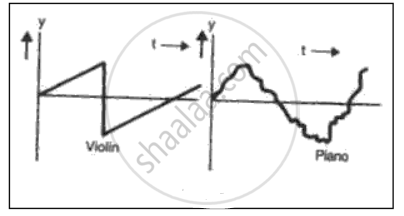Advertisements
Advertisements
प्रश्न
In an experiment, Anhad studies sound waves. He sets up a loudspeaker to produce sound as shown below :
Anhad adjusts the signal to the loudspeaker to give a sound of frequency 200 Hz.
(a) What happens to the air in-between Anhad and the loudspeaker ?
(b) Explain how Anhad receives sound in both ears.
उत्तर
(a) The air in between Anhad and speaker vibrates with the frequency of 200 Hz. Sound is a longitudinal wave, so successive compression and rarefaction is formed between Anhad and the speaker.
(b) Anhad receives sound in the right ear by the sound waves transmitted directly from the loudspeaker, and in his left ear, he receives sound from sound waves reflected from the classroom wall.
APPEARS IN
संबंधित प्रश्न
To detect the obstacles in their path, bats produce ______.
In fig. 2 two musical notes of the same pitch and same loudness are played on a violin and on a piano. Their wave forms are as shown in the diagram below. Explain why the wave patterns are different.

What is the effect of temperature and pressure on the speed of sound in a gas?
What is the SI unit of frequency?
Through which medium sound travels faster, iron or water? Give reason.
What is a longitudinal wave?
Why does an empty vessel produce more sound than a filled one?
Note is a sound
